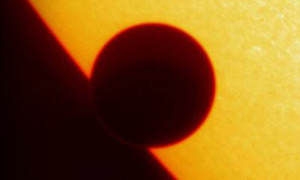 A few weeks ago, many had the rare opportunity to watch a rare solar eclipse. Over the next two days however, an even more rare astronomical event will present those in North America with a truly once in a lifetime event. An opportunity to watch the Venus Transit across the Sun will not occur again until for more than 100 years.
A few weeks ago, many had the rare opportunity to watch a rare solar eclipse. Over the next two days however, an even more rare astronomical event will present those in North America with a truly once in a lifetime event. An opportunity to watch the Venus Transit across the Sun will not occur again until for more than 100 years.
The Venus Transit, is just what the name implies. It is an opportunity to watch the planet Venus pass across the face of the sun. Because Venus is inside the orbit of the Earth, we will have the chance to watch the planet pass between the Earth and the sun. While Venus is much larger than our moon, because it is so much farther away, it will not block out much of the sun the way the moon does during a solar eclipse. But it will still be a spectacular sight to behold.
The 2012 Venus Transit will be the last such event to see until 2117, so as we mentioned in an earlier article, take the opportunity on Tuesday Evening to watch the Venus Transit. Beginning just after 5PM Eastern time, the planet Venus will become visible as a black ball as it begins the transit across the sun.
Those in the Eastern U.S. will be able to keep watching until sunset about half past 7PM Eastern. Those in the central and western parts of the country will have more time to view the transit.
Here is how to Watch the Venus Transit
As we mentioned in out article on watching the last solar eclipse, you should never look directly at the sun to watch a transit or eclipse. To see it through a telescope or with binoculars you MUST use a special solar / sun filter. Otherwise you could use the telescope or binoculars to view the event using a projection method described earlier.
According to leading telescope manufacturer Celestron, “Only six transits of Venus have happened since the invention of the telescope. Occurring in pairs, with eight years separating the two events and more than a century between the pair of transits. The first transit of this century’s pair took place in June 2004, prior to that the last transit was in December 1882 and the next transit will not take place until December 2117! This is a very rare event and should not be missed!”
To celebrate these extraordinary astronomical events, Celestron has unveiled 2 new solar edition telescope packages. The scopes make solar observations, including sun spots, both easy and safe. The removable sun filters in the Solar Observer 60 and Solar Observer 70 allow users to observe the sun during the day and then transition to star-gazing at night.
The Solar Observer 60 Telescope is an easy to use and transport 60 mm telescope, with solar filter and full-height tripod and retails for $79.95. The Solar Observer 70 Telescope also features a 60 mm aperture telescope along with full-height tripod and solar filter, but his model is designed for easy transport by fitting inside the custom backpack, and retails for $99.95.
“These grand celestial events are rare and magnificent to behold,” said Celestron CEO, Joseph A. Lupica, Jr. “Encouraging the public to experience these events provides Celestron with the opportunity to accomplish its mission; to educate and inspire people to look up and enjoy the sky.”
![Herbal Reference Substances are Key to Everyday Products <!-- AddThis Sharing Buttons above -->
<div class="addthis_toolbox addthis_default_style " addthis:url='http://newstaar.com/herbal-reference-substances-are-key-to-everyday-products/3512112/' >
<a class="addthis_button_facebook_like" fb:like:layout="button_count"></a>
<a class="addthis_button_tweet"></a>
<a class="addthis_button_pinterest_pinit"></a>
<a class="addthis_counter addthis_pill_style"></a>
</div>When it comes to quality control testing and the development of new products, Botanical Reference Materials (BRMs), also known as Herbal References are critically important. To help companies ultimately obtain all-important FDA approval, the Food and Drug Administration provides in its guidance a recommendation that […]<!-- AddThis Sharing Buttons below -->
<div class="addthis_toolbox addthis_default_style addthis_32x32_style" addthis:url='http://newstaar.com/herbal-reference-substances-are-key-to-everyday-products/3512112/' >
<a class="addthis_button_preferred_1"></a>
<a class="addthis_button_preferred_2"></a>
<a class="addthis_button_preferred_3"></a>
<a class="addthis_button_preferred_4"></a>
<a class="addthis_button_compact"></a>
<a class="addthis_counter addthis_bubble_style"></a>
</div>](http://newstaar.com/wp-content/uploads/2021/02/Achillea_millefolium_flowers-100x100.jpg)
![Quality Electrochemical Biosensors are Critical for Medical, Food and Chemical Industry <!-- AddThis Sharing Buttons above -->
<div class="addthis_toolbox addthis_default_style " addthis:url='http://newstaar.com/quality-electrochemical-biosensors-are-critical-for-medical-food-and-chemical-industry/3512086/' >
<a class="addthis_button_facebook_like" fb:like:layout="button_count"></a>
<a class="addthis_button_tweet"></a>
<a class="addthis_button_pinterest_pinit"></a>
<a class="addthis_counter addthis_pill_style"></a>
</div>A number of industries have, at their core, a need to frequent or even continuous analysis of biological media. These include the medical and pharmaceutical fields, biotech firms, and food and chemical companies. To maintain quality standards and develop new products, these industries rely heavily […]<!-- AddThis Sharing Buttons below -->
<div class="addthis_toolbox addthis_default_style addthis_32x32_style" addthis:url='http://newstaar.com/quality-electrochemical-biosensors-are-critical-for-medical-food-and-chemical-industry/3512086/' >
<a class="addthis_button_preferred_1"></a>
<a class="addthis_button_preferred_2"></a>
<a class="addthis_button_preferred_3"></a>
<a class="addthis_button_preferred_4"></a>
<a class="addthis_button_compact"></a>
<a class="addthis_counter addthis_bubble_style"></a>
</div>](http://newstaar.com/wp-content/uploads/2020/10/Electrochemical-Biosensor-100x100.jpg)
![Company Develops Industrial Mixers Well-Suited for both Fragile and Explosive Products <!-- AddThis Sharing Buttons above -->
<div class="addthis_toolbox addthis_default_style " addthis:url='http://newstaar.com/company-develops-industrial-mixers-well-suited-for-both-fragile-and-explosive-products/3512071/' >
<a class="addthis_button_facebook_like" fb:like:layout="button_count"></a>
<a class="addthis_button_tweet"></a>
<a class="addthis_button_pinterest_pinit"></a>
<a class="addthis_counter addthis_pill_style"></a>
</div>Industrial drum mixers are normally applied to blend mixes of varying viscosities such as adhesive slurries or cement. Some of these mixers have the capability of blending mixes of very different particle sizes such as fruit and ice cream, and gravel and cement slurry. The […]<!-- AddThis Sharing Buttons below -->
<div class="addthis_toolbox addthis_default_style addthis_32x32_style" addthis:url='http://newstaar.com/company-develops-industrial-mixers-well-suited-for-both-fragile-and-explosive-products/3512071/' >
<a class="addthis_button_preferred_1"></a>
<a class="addthis_button_preferred_2"></a>
<a class="addthis_button_preferred_3"></a>
<a class="addthis_button_preferred_4"></a>
<a class="addthis_button_compact"></a>
<a class="addthis_counter addthis_bubble_style"></a>
</div>](http://newstaar.com/wp-content/uploads/2020/06/bandeau-sofragir2-100x100.jpg)